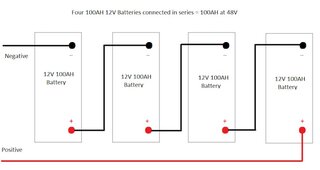Thank you for the abundance of knowledge you share on this forum. I'll be reading for months. I only wish I'd found you before I got in so far over my head. I thought I knew what I was doing. I don't.
I have 4 brand new 100ah 12v weize lifepo4 batteries connected in series to a 48v renogy 3500 watt inverter/charger. The charger happily charges the batteries all day from solar panels. In the evening, a battery BMS beeps for overvoltage and since the inverter is 48v only, the system shuts down. The battery has over charged to an astonishing 36 volts. As per the manufacturer's instructions, I disconnected the battery and the BMS sheds voltage back down to 13.6. i wire the batteries in parallel to rebalance. Then the cycle repeats the next day with a different battery. If I follow the manufacturer's advice and reconnect immediately after the BMS resets, the battery over charges within minutes of powering up the inverter/charger.
After reading awhile here i have learned that I know nothing about batteries and it will be sooner time before I know enough to fix this problem. Maybe the cells in the batteries are out of balance?
I would be very grateful for any advice on how to proceed. We are entirely off grid and have been without power for a few weeks now. I'd love to be able to use at least some of the power the panels are putting out, even if I can't get the battery bank problem fully resolved.
2potatoes ( well 2 varieties anyway)
I have 4 brand new 100ah 12v weize lifepo4 batteries connected in series to a 48v renogy 3500 watt inverter/charger. The charger happily charges the batteries all day from solar panels. In the evening, a battery BMS beeps for overvoltage and since the inverter is 48v only, the system shuts down. The battery has over charged to an astonishing 36 volts. As per the manufacturer's instructions, I disconnected the battery and the BMS sheds voltage back down to 13.6. i wire the batteries in parallel to rebalance. Then the cycle repeats the next day with a different battery. If I follow the manufacturer's advice and reconnect immediately after the BMS resets, the battery over charges within minutes of powering up the inverter/charger.
After reading awhile here i have learned that I know nothing about batteries and it will be sooner time before I know enough to fix this problem. Maybe the cells in the batteries are out of balance?
I would be very grateful for any advice on how to proceed. We are entirely off grid and have been without power for a few weeks now. I'd love to be able to use at least some of the power the panels are putting out, even if I can't get the battery bank problem fully resolved.
2potatoes ( well 2 varieties anyway)



